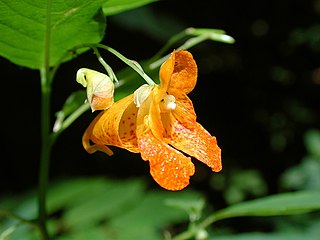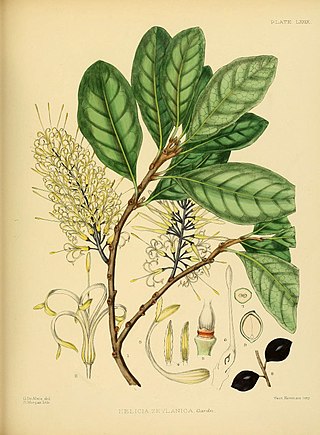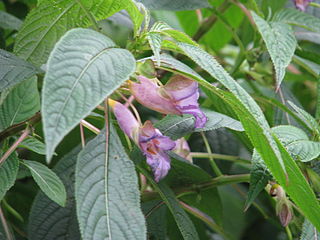
Impatiens is a genus of more than 1,000 species of flowering plants, widely distributed throughout the Northern Hemisphere and the tropics. Together with the genus Hydrocera, Impatiens make up the family Balsaminaceae.

Mount Cameroon is an active volcano in the South West region of Cameroon next to the city of Buea near the Gulf of Guinea. Mount Cameroon is also known as Cameroon Mountain or Fako or by its indigenous name Mongo ma Ndemi. Mount Cameroon is ranked 22nd by topographic isolation.

Impatiens walleriana, also known as busy Lizzie, balsam, sultana, or simply impatiens, is a species of the genus Impatiens, native to eastern Africa from Kenya to Mozambique. The Latin specific epithet walleriana honours a British missionary, Horace Waller (1833–1896).

Impatiens capensis, the orange jewelweed, common jewelweed, spotted jewelweed, jewelweed, spotted touch-me-not, or orange balsam, is an annual plant in the family Balsaminaceae that is native to North America. It is common in bottomland soils, ditches, and along creeks, often growing side by side with its less common relative, yellow jewelweed.

Impatiens balsamina, commonly known as balsam, garden balsam, rose balsam, touch-me-not or spotted snapweed, is a species of plant native to India and Myanmar.

Helicia is a genus of 110 species of trees and shrubs, constituting part of the plant family Proteaceae. They grow naturally in rainforests throughout tropical South and Southeast Asia, including India, Sri Lanka, Indochina, Peninsular Malaysia to New Guinea and as far south as New South Wales.
Impatiens etindensis is a species of flowering plant in the family Balsaminaceae. It is endemic to Cameroon, where it is known only from Mount Cameroon. It grows as an epiphyte on trees in mountain forest habitat.
Impatiens frithii is a species of flowering plant in the family Balsaminaceae. It is endemic to Cameroon, where it has been found in the Bakossi Mountains and on Etinde, part of Mount Cameroon. It is an epiphyte growing on small trees and shrubs in elfin forest habitat. It is small and inconspicuous when not bearing its bright red flowers.
Impatiens grandisepala is a species of flowering plant in the family Balsaminaceae. It is endemic to Cameroon, where it is known only from Mount Cameroon. It has been collected only once, in 1979. It is an epiphyte that grows in shady mountain forest habitat.
Impatiens letouzeyi is a species of flowering plant in the family Balsaminaceae. It is endemic to Cameroon, where it occurs in the Bakossi Mountains. It grows as an epiphyte in trees and shrubs, as well as a terrestrial herb. It is threatened by plans for the construction of a reservoir in the area.
Impatiens meruensis is a species of flowering plant in the family Balsaminaceae. It is found in Kenya, Sudan, Tanzania, and Uganda. Its natural habitats include mountain forests, streambanks, and swamps. It may grow in the spray zones of waterfalls. It is generally a widespread species in its range, at least in the uplands of Kenya. Including the forests of Cherangani hills.
Impatiens obesa is a species of plant in the family Balsaminaceae. It is endemic to China.

Impatiens omeiana is a species of flowering plant in the family Balsaminaceae. It is endemic to China, where it occurs in Sichuan.
Impatiens pritzelii is a species of plant in the family Balsaminaceae. It is endemic to China.

Impatiens sakeriana is a perennial species of flowering plant in the family Balsaminaceae. It is native to Cameroon and Equatorial Guinea and grows in mountain forest understory habitat at elevations up to 3000 meters. I. sakeriana is most often cited for its role in sunbird pollination. It can be locally common in parts of its range, but its habitat is threatened by agriculture.
Impatiens wilsoni is a species of flowering plant in the family Balsaminaceae. It is endemic to China, where it is known only from Sichuan.

Impatiens parviflora is a species of annual herbaceous plants in the family Balsaminaceae, native to some areas of Eurasia, naturalized elsewhere and found in damp shady places. Impatiens parviflora can grow in sandy, loamy, and clay soils and prefer moist soil.

Impatiens balfourii is a species of the genus Impatiens known by the common names Balfour's touch-me-not, Kashmir balsam, and poor man's orchid. It belongs to the family Balsaminaceae.

Euprymna morsei, the Mimika bobtail squid, is a species of Indo-Pacific bobtail squid from the family Sepiolidae.

Impatiens arguta, the toothed busy lizzie, is a species of flowering plant in the balsam family Balsaminaceae. It is native to Bhutan, Nepal, Myanmar, India and China. This herbaceous perennial grows to 30 cm (12 in) tall and broad, with an erect habit. It has deeply-veined, elliptic, slightly toothed leaves. Delicate lavender-blue or pink flowers appear in summer. As with other Impatiens species, the stems and leaves are succulent and fleshy.













